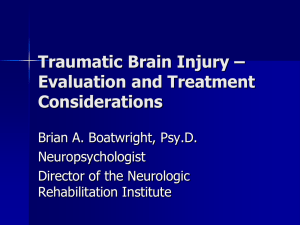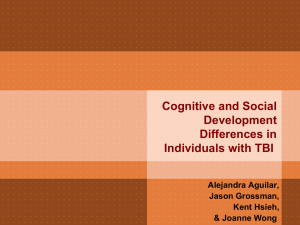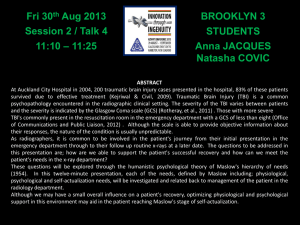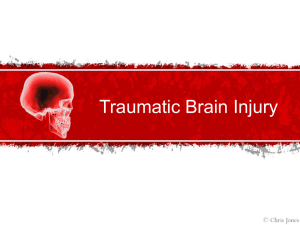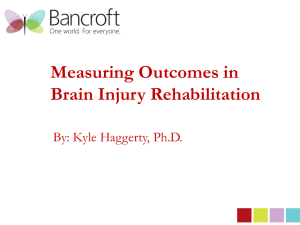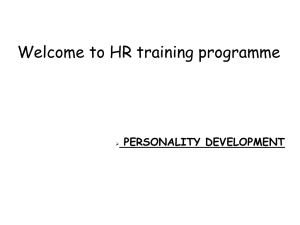Personality Changes Following Brain Injury: Outline
advertisement
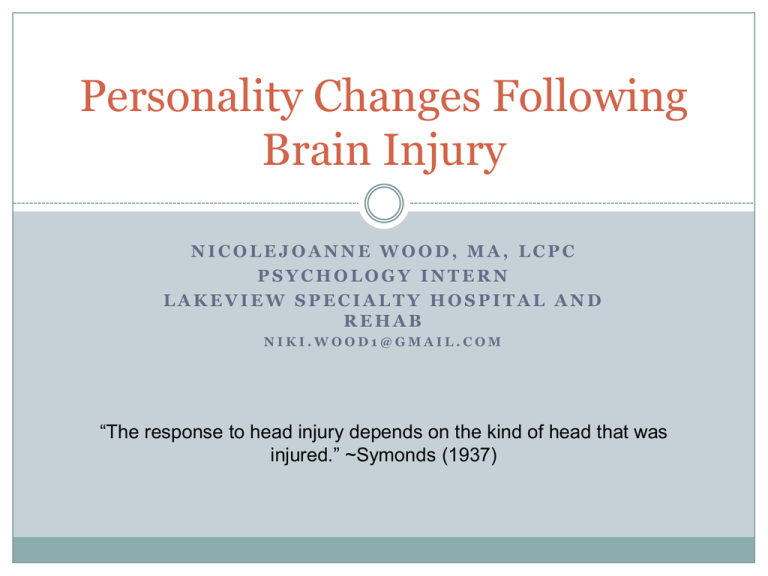
Personality Changes Following Brain Injury NICOLEJOANNE WOOD, MA, LCPC PSYCHOLOGY INTERN LAKEVIEW SPECIALTY HOSPITAL AND REHAB NIKI.WOOD1@GMAIL.COM “The response to head injury depends on the kind of head that was injured.” ~Symonds (1937) Review influential case- Phineas Personality Changes Following Brain Injury: Outline Gage Introduction Prevalence Types of personality and behavioral changes Comorbid or other associated new-onset disorders Outcome and treatment References A Classic Example: Phineas P. Gage “NO LONGER GAGE” Phineas P. Gage September 1848: 25-year-old Gage was struck with a tamping iron 13 pounds, 3 feet 7 inches in length, and 1 ¼ inch in diameter Passed mostly through the left frontal lobe April 1849: Almost complete physical recovery However, it seems that Gage’s personality changed dramatically. Fitful, irreverent, engages in profanity Little respect for others Impatient when conflicts with his desires Very stubborn Abandons plans Introduction: ‘The walking wounded’ Traumatic Brain Injury (TBI): Insult to the brain caused by external physical force May produce a diminished state of consciousness Usually results in impairment of cognitive abilities or physical functioning, as well as: Mood Personality Impulsive aggression Impaired self-regulatory behavior TBIs often considered a risk factor for psychiatric disorders Severity of TBI Classification Criteria using the Glascow Coma Scale (GCS), Loss of Consciousness (LOC), and Posttraumatic Amnesia (PTA) Classification GCS LOC PTA Mild ≥13 <20 mins1 hour <24 hours Moderate 9-12 1-24 hours >24 hours to <7 days Severe ≤8 (in a coma) >24 hours >7 days High risk groups Males 15-24 years old Substance abusers Infants (64% due to child abuse) Elderly Individuals who have had a prior brain injury Prevalence: Note: All prevalence rates are approximations. Prevalence rates for TBI are high 5.3 million Americans disabled secondary to TBI TBIs common cause of childhood acquired disability 475,000 TBIs occur among children ages 0-14 years (1 year; United States only) 1.4 million people sustain a TBI; about 50,000 die, 235,000 are hospitalized, and 1.1 million are treated and released (1 year; United States only) Behavioral changes after TBI: 10-21% (mild); 62-67% (severe) Personality changes after TBI: Approximately 60-80% Types of behavioral and personality changes: Taken from a study by Max, Robertson, & Lansing (2001) Symptom Percentage Personality change 57% Affective instability 49% Marked shifts from normal mood to •Depression •Irritability •Anxiety •8% •41% •5% Laughs inappropriately and/or excessively 24% Pathological crying 19% Recurrent outbursts of 38% aggression or rage that are grossly out of proportion to any precipitating stressors Markedly impaired social judgment 38% Symptom Percentage Uninhibited/disinhibited •Acts •Verbalization •32% •41% Lack of tact or concern for others; not sensitive to other’s feelings/reactions 22% Inability to plan ahead 27% Sexually inappropriate 16% Marked apathy or indifference 14% Suspiciousness or paranoid ideation 5% Explosive 32% Perseveration 35% Immaturity 24% 5 major subtypes of personality change: Affective liability Aggression Disinhibition Apathetic Paranoid Facial affect recognition difficulties Especially negative emotions: Anger, disgust, sadness, and fear Aggressive behavior Higher incidence of pre-morbid aggressive behavior Sexually intrusive behavior 70% Personality functioning Decreases in Extraversion Openness Agreeableness Conscientiousness Increase in Neuroticism Elevations in personality disorder traits (Axis II) Histrionic Narcissistic Compulsive Dependent Avoidant Paranoid Schizoid Psychiatric disorders (Axis I) Disorder TBI Population General Population Major Depression 44.3% 5-9% (females); 23% (males) point prevalence Generalized Anxiety Disorder 9.1% 5% Bipolar Disorder 4.2% 0.4-1.6% Obsessive-Compulsive Disorder 6.4% 0.5-2.1% Panic Disorder 9.2% 1-2% Posttraumatic Stress Disorder 14.1% 8% Schizophrenia 0.7% 0.5-1.5% Substance Abuse 13% Other neuropsychiatric sequelae after TBI Psychosis- 0.7-9.8% Psychosocial problems Increasing unemployment rates Effects on family members 73% of spouses have at least mild depression 42-64% of couples eventually divorce Disruptions in family functioning- less effective coping, problem-solving and communication Judgment of personality change Example of disinhibited behavior and impaired social judgment Taken from a study by Max, Robertson, & Lansing (2001) 12-year-old female (1 year post): “At least I don’t bite anymore” 7-year-old male (6 months post): “He is more outspoken and blunt” 7-year-old female (1 year post): “Get back at other people” 6-year-old male (3 years post): “Boy, you’re fat” Several additional characteristics that affect personality change after TBI Anosognosia Executive dysfunction Apathy Hope Optimism Anosognosia (Awareness/Insight) Observed when patient does not report, denies or minimizes difficulties Possibly used as a defense mechanism against the reality of life post-injury Over time, impaired awareness may lead to increased distress Less insight = more behavioral problems and familial stress 3 possible types of deficits in awareness Intellectual awareness of deficits Emergent awareness deficits Anticipatory awareness Executive dysfunction Purposeful, goal-directed, problemsolving behaviors Sub-components may include Attentional control Strategic planning and problem-solving Cognitive flexibility of thought and action Concept formation and abstraction Information processing Apathy Occurs in about 66-71% of TBI population May be treated pharmacologically Hope and optimism Hope An inner feeling that a problem will ultimately be solved Negatively related to general maladjustment and suicidal ideation More dominant in predicting depression severity Optimism Future orientation with a general expectancy that good rather than bad will happen Personality change after TBI is Comorbid or Other Associated New Onset Disorders significantly associated with new onset disorders in children Outcome- males versus females Outcome and Treatment: Multifaceted rehabilitation Cognitive rehabilitation Behavioral treatment Social skills training Vocational training Individual therapy Group therapy Family therapy Parenting skills programs Social-emotional factors Parental warmth and responsiveness Intervention strategy recommendations ElementarySupervision Behavioral strategies Clearly differentiate appropriate and inappropriate boundaries and behaviors Pharmacological interventions Recommendations influenced by Bezeau, Bogod, & Mateer (2004) IntermediatePsychoeducation Practice social skills Discuss emotions and thoughts AdvancedEstablish behavior relapse plan Challenge cognitive distortions Brain Injury Family Intervention (BIFI) (Kreutzer et al., 2009) BIFI/BIFI-A Structured treatment for TBI patients and their families 5-6 sessions; 90-120 minutes each BIFI topics Effects of brain injury on the survivor and family Understanding recovery Solving problems and setting goals Managing stress and intense emotions Strategies for optimal recovery Brain Injury Family InterventionAdolescent (BIFI-A) (Gan et al., 2010) Rehabilitation approaches Direct approach Restorative interventions Behavioral compensation Environmental modification Problem-solving Example 5-step flow chart with feedback loops 1. STOP: What am I doing? 2. DEFINE: The main task 3. LIST: The steps 4. LEARN: The steps and do it 5. CHECK: Am I doing what I planned to do? Conclusions Traumatic Brain Injury (TBI) Insult to brain that may cause impairments in behavioral, emotional, cognitive, and physical functioning 5.3 million Americans disabled secondary to TBI Changes affecting personality include: Mood (depression, anxiety, etc.) Behavior (disinhibition, aggression, etc.) Executive functioning (anosognoia, planning, apathy, etc.) Numerous neuropschological aspects affect personality functioning Co-morbid disorders ADHD Oppositional Defiant Disorder Anxiety Depression Treatment considerations Multifaceted Include families References American Psychiatric Association. (2000). Diagnostic and statistical manual of mental disorders (Revised 4th ed.). Washington, DC: Author. Anderson, V., Brown, S., Newitt, H., & Hoile, H. (2011). Long-term outcome from childhood traumatic brain injury: intellectual ability, personality, and quality of life. Neuropsychology, 25(2), 176-184. Andersson, S., Gundersen, P.M. & Finset, A. (1999). Emotional activation during therapeutic interaction in traumatic brain injury: effect of apathy, self-awareness and implications for rehabilitation. Brain Injury, 13(6), 393-404. Armstrong, C. (1991). Emotional changes following brain injury: Psychological and neurological components of depression, denial and anxiety. Journal of Rehabilitation, 15-22. Babbage, D., Yim, J., Zupan, B., Neumann, D., Tomita, M.R., & Willer, B. (2011). Meta-analysis of facial affect recognition difficulties after traumatic brain injury. Neuropsychology, 25(3), 277-285. Bezeau, S.C., Bogod, N.M., & Mateer, C.A. (2004). Sexually intrusive behaviour following brain injury: approaches to assessment and rehabilitation. Brain Injury, 18(3), 299-313. Catroppa, C., & Anderson, V. (2006). Planning, problem-solving and organizational abilities in children following traumatic brain injury: Intervention techniques. Pediatric Rehabilitation, 9(2), 89-97. Gan, C., Gargaro, J., Kreutzer, J.S., Boschen, K.A., & Wright, F.V. (2010). Development and preliminary evaluation of a structured family system intervention for adolescents with brain injury and their families. Brain Injury, 24(4), 651-663. Ganesalingam, K., Yeates, K.O., Taylor, H.G., Walz, N.C., Stancin, T., & Wade, S. (2011). Executive functions and social competence in young children 6 months following traumatic brain injury. Neuropsychology, 25(4), 466-476. Golden, Z., & Golden, C.J. (2003). Impact of brain injury severity on personality dysfunction. International Journal of Neuroscience, 113, 733-745. Golden, Z., & Golden, C.J. (2003). The differential impacts of alzheimer’s dementia, head injury, and stroke on personality dysfunction. International Journal of Neuroscience, 113, 869-878. Greve, K.W., Sherwin, E., Stanford, M.S., Mathias, C., Love, J., & Ramzinski, P. (2001). Personality and neurocognitive correlates of impulse aggression in long-term survovors of severe traumatic rain injury. Brain Injury, 15(3), 255262. Grieve, A.W. (2010). Phineas P Gage- ‘The man with the Iron bar.’ Trauma, 12, 171-174. Heberlein, A.S., Adolphs, R., Pennebaker, J.W., & Tranel, D. (2003). Effects of damage to right-hemisphere brain structures on spontaneous emotional and social judgments. Political Psychology, 24(4), 705-726. Jennekens, N., Dierckx de Casterle, B., & Dobbels, F. (2010). A systematic review of care needs of people with traumatic brain injury (TBI) on a cognitive, emotional and behavioural level. Journal of Clinical Nursing, 19, 1198-1206. Kant, R., Duffy, J.D., & Pivovarnik, A. (1998). Prevalence of apathy following head injury. Brain Injury, 12(1), 87-92. Kreutzer, J.S., Stejskal, T.M., Ketchum, J.M., Marwitz, J.H., Taylor, L.A., & Menzel, J.C. (2009). A preliminary investigation of the brain injury family intervention: Impact on family members. Brain Injury, 23(6), 535-547. Maillard-Wermelinger, A., Yeates, K.Ow., Taylor, H.G., Rusin, J., Bangert, B., Dietrich, A., Nuss, K., & Wright, M. (2009). Mild traumatic brain injury and executive functions in school-aged children. Developmental Neurorehabilitation, 12(5), 330-341. Max, J.E., Levin, H.S., Schachar, R.J., Landis, J., Saunders, A.E., Ewing-Cobbs, L., Chapman, S.B., & Dennis, M. (2006). Predictors of personality change due to traumatic brain injury in children and adolescents six to twenty-four months after injury. The Journal of Neuropsychiatry and Clinical Neurosciences, 18, 21-32. Max, J.E., Robertson, B.A.M.; & Lansing, A.E. (2001). The phenomenology of personality change due to traumatic brain injury in children and adolescents. The Journal of Neuropsychiatry and Clinical Neurosciences, 13, 161-170. McBrinn, J., Wilson, F.C., Caldwell, S., Carton, S., Delargy, M., McCann, J., Walsh, J., & McGuire, B. (2008). Emotional distress and awareness following acquired brain injury: An exploratory analysis. Brain Injury, 22(10), 765-772. Miller, L.J., & Donders, J. (2001). Subjective symptomatology after traumatic head injury. Brain Injury, 15(4), 297-304. Murrey, G.J., Hale, F.M., & Williams, J.D. (2005). Assessment of anosognosia in persons with frontal lobe damage: Clinical utility of the Mayo-Portland adaptability inventory (MPAI). Brain Injury, 19(8), 599-603. Park, E., Bell, J.D., & Baker, A.J. (2008). Traumatic brain injury: Can the consequences by stopped? Canadian Medical Association Journal, 178(9), 1163-1170. Peleg, G., Barak, O., Harel, Y., Rochberg, J., & Hoofien, D. (2009). Hope, dispositional optimism and severity of depression following traumatic brain injury. Brain Injury, 23(10), 800-808. Port, A., Willmott, C., & Charlton, J. (2002). Self-awareness following traumatic brain injury and implications for rehabilitation. Brain Injury, 16(4), 277-289. Rao, V., & Lyketsos, C. (2000). Neuropsychiatric sequelae of traumatic brain injury. Psychosomatics, 41(2), 95-103. Ruocco, A.C. Swirsky-Sacchetti, T., & Choca, J.P. (2007). Assessing personality and psychopathology after traumatic brain injury with the Millon Clinical Multiaxial Inventory-III. Brain Injury, 21(12), 1233-1244. Sbordone, R.J., Seyranian, G.D., & Ruff, R.M. (1998). Are the subjective complaints of traumatically brain injured patients reliable? Brain Injury, 12(6), 505-515. Slewa-Younan, S., Baguley, I.J., Heriseanu, R., Cameron, I.D., Pitsiavas, V., Mudaiar, Y., & Nayyar, V. (2008). Do men and women differ in their course following traumatic brain injury? A preliminary prospective investigation of early outcome. Brain Injury, 22(2), 183-191. Symonds, C.P. (1937). Mental disorder following head injury. Proceedings of the Royal Society of Medicine, 30, 1081-1092. Tellier, A., Marshall, S.C., Wilson, K.G., Smith, A., Perugini, M., & Stiell, I.G. (2009). The heterogeneity of mild traumatic brain injury: Where do we stand? Brain Injury, 23(11), 879-887. van Reekum, R., Cohen, T., & Wong, J. (2000). Can traumatic brain injury cause psychiatric disorders? The Journal of Neuropsychiatry and Clinical Neurosciences, 12, 316-327. Wade, S.L., Cassedy, A., Walz, N.C., Taylor, H.G., Stancin, T., & Yeates, K.O. (2011). The relationship of parental warm responsiveness and negativity to emerging behavior problems following traumatic brain injury in young children. Developmental Psychology, 47(1), 119-133. Weddell, R.A., & Leggett, J.A. (2006). Factors triggering relatives’ judgments of personality change after traumatic brain injury. Brain Injury, 20(12), 1221-1234. http://www.cdc.gov/injury/wisqars/LeadingCauses.html http://www.cdc.gov/ncipc/pub-res/tbi_in_us_04/tbi_ed.htm
